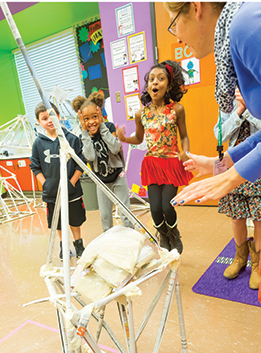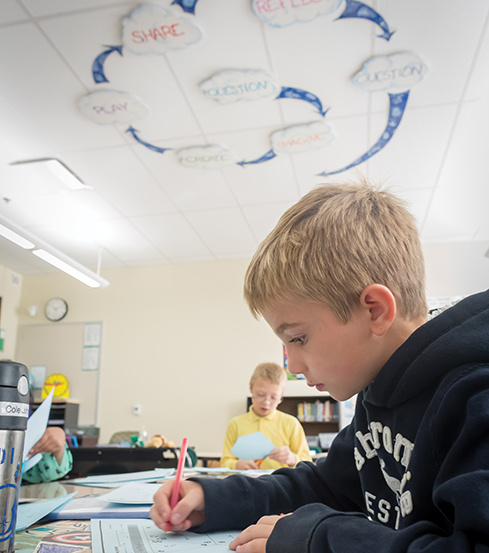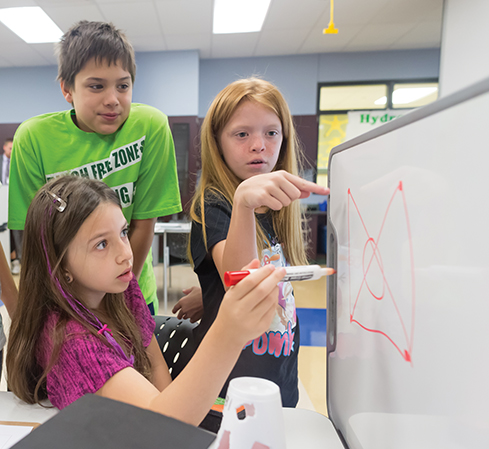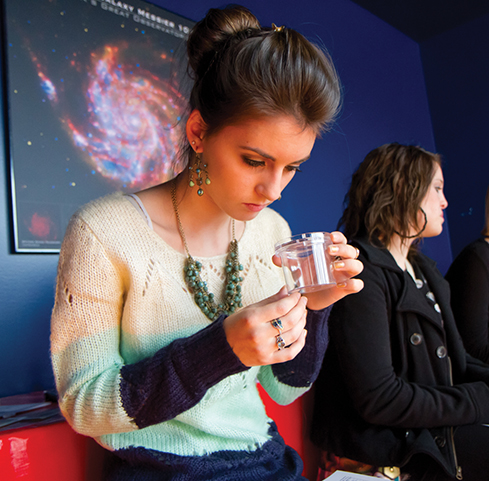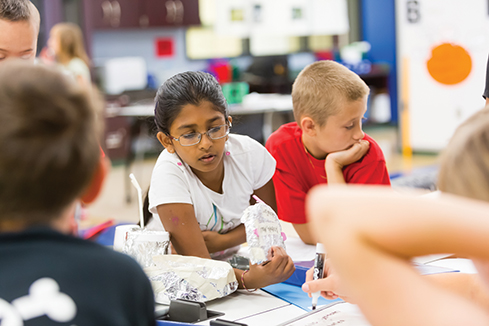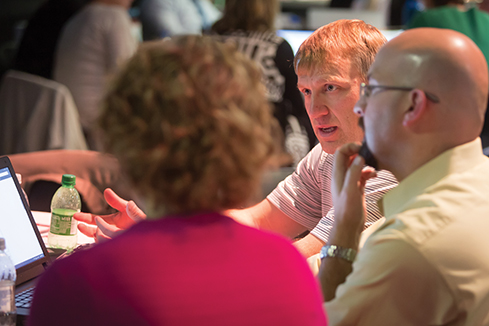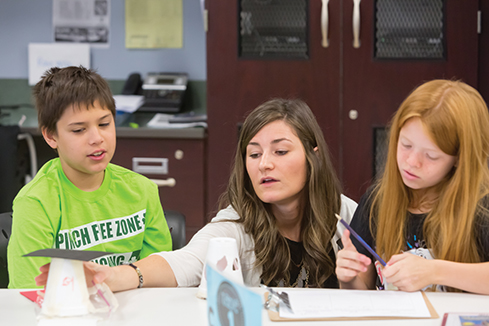 |
|||||||||||||||||||
| How Carnegie Science Center and schools across the region are putting STEM (science, technology, engineering, and math) learning in its rightful place—everywhere.
Upon reading The Three Little Pigs: An Architectural Tale, the teams were asked to build sizeable structures that can hold weight. Working together through trial and error, they considered the different shapes that might best stand up to stress (triangles topped the list). They sketched out their ideas on paper, then built 3D models out of spaghetti and miniature marshmallows. Finally, using the tools at their disposal—in this case, masking tape and rolled up newspapers—they brought their concepts to life. The hands-on challenge did what it set out to do: get 8- and 9-yearolds thinking like builders—each assuming the role of problem solver and facilitator, innovator and team player. “We’re moving away from book learning,” says South Fayette’s assistant superintendent, Michael R. Loughead. “We’re focusing on the key skills industries expect, the core skills students will need to function in college and the real world.” At the sprawling suburban campus south of Pittsburgh and in districts around the region and the country, real-world learning can and does start in pre-kindergarten. That’s the goal. And the means of achieving that goal is through integrated STEM education. An acronym for science, technology, engineering, and math, STEM represents an integrated, real-world approach to preparing kids to take on the challenges of the day—think climate change, renewable energy, infectious diseases, cyber security.
At Carnegie Science Center, such challenges are old hat; informal STEM education is what it’s been doing since its inception in 1991. Among its numerous educational programs, the Science Center boasts one of the longest running science fairs in the country. The Science Center reaches some 10,000 regional students, more than half of them girls, through a slew of award-winning STEM programs, including the Pittsburgh Regional Science and Engineering Fair, ChemFest, the Student Energy Summit, the girls-focused STEM Stars, and annual SciTech Days, where, under the guidance of working scientists and industry leaders, some 6,000 students and their teachers participate in hands-on workshops designed to capture interest in the everyday applications of STEM subjects. In 2011, the Science Center launched its Chevron Center for STEM Education and Career Development, which became a reality through the support of business and academic partners across the region that view the Science Center as central in helping them inspire, educate, and train the STEM workforce of the future. “It’s really remarkable and exciting; the Science Center has become the region’s respected convener on STEM,” says Jerry Whitaker, the retired president of Eaton Corporation’s Electrical Sector who now serves as chair of the Science Center board. “The Science Center team is bringing community voices together in meaningful ways not only to raise awareness about the critical nature of STEM education, but to make a real difference in how our schools integrate STEM learning into their curriculum.”
According to Alana Kulesa, director of strategic education initiatives at the Science Center, “A lot of schools know STEM is important and they’re focusing on it, but they don’t have a common language to define what that is, or how to measure it.” In response, the Science Center teamed up with regional stakeholders to develop the Carnegie STEM Excellence Pathway, a selfassessment process supported by The Heinz Endowments that helps schools define and gauge the quality of their STEM programs and ways to improve them. In early October, teams of educators and administrators from 13 regional schools and school districts, including South Fayette, attended a day-long workshop at the Science Center, kicking off their participation in the Pathway. Sto-Rox and Upper St. Clair, which joined South Fayette in piloting the programming last school year, are beginning year two. The group was also among the first to see the results of a hot-off-the-press study conducted by the Science Center on STEM awareness and perceptions among regional educators, business leaders, parents, and students (see below). The new Pathway initiative, like all Science Center STEM programming, focuses on the four fundamentals of effective STEM education, as the Science Center defines them: inquiry-based science and math, when both teachers and students are challenged to think outside the lecture; an integrated curriculum, in which no subject is an island independent of other disciplines; project-based group learning, such as Unger’s second-grade class; and career awareness, the answer to that age-old question—What do you want to be when you grow up? In other words, says Kulesa, “STEM is about making sure students have what it takes to find success in a globally-competitive marketplace.” The big-picture hope is that a STEM education will translate to well-paying, potentially life-changing, even planet-saving, jobs. “It’s not about a + b = c anymore. We’re preparing students for careers or jobs we don’t even know about yet.”
- MICHAEL GHILANI, HIGH SCHOOL PRINCIPAL AT UPPER ST. CLAIRThe STEM gapBut the numbers aren’t exactly adding up. According to the Bureau of Labor Statistics, last year STEM jobs approached the 17 million mark—accounting for roughly 13 percent of the nation’s total employment. Yet 2 to 3 million positions remained unfilled because companies can’t find workers with basic technical skills. In Pittsburgh’s technology sectors, at least 2,000 STEM positions remained unfilled in 2013, jeopardizing the region’s economic future. Experts predict that, nationwide, there will be some 10 million job vacancies before the end of the decade. The U.S. Department of Education breaks it down further. By 2020, it’s estimating a 60-plus percent increase in biomedical engineering jobs and a 30-plus percent surge in systems software developers. For the immediate future, it looks like the gap between job openings and qualified applicants will continue to expand. According to the Department of Education, nearly 85 percent of American high school seniors aren’t proficient in mathematics and show little or no interest in STEM careers.
More sobering news: In terms of world rankings—specifically, the most recent surveys conducted by the Trends in International Mathematics and Science Study (TIMSS) and the Program for International Student Assessment (PISA)—America’s students are playing catch up at all age levels, more so once they hit high school. The 2012 PISA assessed the competencies of 15-year-olds in reading, science, and mathematics. Of the 65 participating countries, U.S. students ranked 24th in reading, 28th in science, and 36th in math. Of course, national rankings, STEM job openings—none of these grown-up worries are on the minds of South Fayette second graders. On this September morning, all of their attention is focused on Ms. Unger, their teacher, as she approaches Team 4’s Eiffel Towerinspired creation and loads onto it a two-pound bag of sand. There’s a gasp. Then a cheer. Barely able to contain their excitement, team members Chloe, Royce, Madisyn, and Nidhi watch anxiously as another two pounds is ever-so-gently placed on top. The tower remains upright—for now. The flexibility to learnSouth Fayette is Allegheny County’s fastest growing school district, with a 45 percent bump in enrollment since 2004. And if projections hold true, the total number of students will increase another 38 percent over the next decade. To support that growth, a new intermediate school for grades 3 through 5 opened last year. Not surprisingly, plans are under consideration to add some 47,000 square feet of classroom and flexible space to the high school, which was built in 2002. With STEAM (STEM + art) education a district-wide initiative, the new intermediate school was built specifically for it. Designed with maximum flexibility in mind, three STEAM studios—focusing on environment and ecology, Earth and space, and robotics— feature high-tech gadgets, in-class sinks, and tables and chairs that are easily moved and reconfigured to enhance teamwork and hands-on learning.
Of course, not every school has these resources. “That’s why the Pathway meets districts where they are, and encourages meaningful collaboration,” Kulesa says. “Sto-Rox is financially strapped,” notes Melanie Kerber, a former middle school principal at Sto-Rox who is now superintendent of the Blackhawk School District. “We were taking baby steps.” But by teaming up with Upper St. Clair robotics students like junior Ananya Cleetus, she says, seventh-grade Sto- Rox students were able to take a leap forward. When Cleetus is not showing President Obama her robotic hand designed to help leprosy patients (she was the only Pennsylvania student to participate in this year’s White House Science Fair), she’s working with her peers at Sto-Rox. And according to Michael Ghilani, high school principal at Upper St. Clair, the partnership is “bringing a lot of benefits to both of our schools.” This fall, 34 high students from Upper St. Clair and South Fayette teamed up via videoconference to brainstorm solutions for real-world problems, such as how to increase productivity and efficiency for two real-world companies, All-Clad Metalcrafters, a Canonsburg cookware maker, and EAFab Corp., an Oakdale steel mill products manufacturer. “It’s not about a + b = c anymore,” Ghilani says. “We’re preparing students for careers or jobs we don’t even know about yet.” The foundation of STEM, he adds, doesn’t rest in finding the single right answer, but rather asking all the right questions. STEM begins at home“By championing input from schools, the local university community, and community development stakeholders, the Carnegie STEM Excellence Pathway is an evaluation tool by schools for schools,” says Ron Baillie, the Henry Buhl, Jr., Co-director of Carnegie Science Center. It encourages districts and individual schools to examine six key areas: teacher qualifications, curriculum, instructional practices, assessment and demonstration of skills, family engagement, and the ever-important real world connections.
“We don’t expect every student to go into a STEM career. But we do want them to be STEMliterate, to be able to think critically, solve problems, work in teams, and communicate effectively.”
- ALANA KULESA, DIRECTOR OF STRATEGIC EDUCATION INITIATIVES AT THE SCIENCE CENTER“The tool is good, and the time is right,” says Martha McCabe of the Kansas City STEM Alliance. Nearly all of the 26 Missouriand Kansas-based school districts the organization works with, as well as several charter and private schools, recently attended a Science Center-facilitated Pathway workshop in Kansas City. “It was the first time we all sat together in a coordinated effort and focused on STEM and our next steps,” McCabe says. “It only makes sense to learn from each other.” To date, 57 schools and districts have signed on as Pathway Partners, representing nearly 250 educators from more than 535 schools and some 313,500 students from Pennsylvania, Missouri, and Kansas. Impressive numbers for a program that officially kicked off in September. “For us,” South Fayette’s Loughead says, “it provides a good benchmark of what a successful program looks like in elementary, middle, and high school.” An easy win for South Fayette, for example, is its decision to teach computer science from pre-K through 12th grade.
Recognizing that a child’s learning begins at home, the Science Center included families in its recent STEM survey. “At the Science Center,” says co-director Ann Metzger, “we’re involved in discussions about STEM education every day. We wanted to know how others view its importance, what they see as the potential benefits, what they want for their children, and what they perceive as the barriers.” The quick takeaway: Parents don’t quite get it. What parents seem to be struggling with is how STEM will impact their children. Many students won’t grow up to become mechanical engineers, nuclear physicists, or computer programmers, and many will opt out of four-year universities in favor of two-year community colleges or technical schools. And that’s more than okay, says Kulesa, because educators and business leaders agree that STEM education benefits all students, regardless of the path they may take. What’s more, STEM skills are needed for jobs across many different industries, from photography to nutrition, animation, and video-game design. “We don’t expect every student to go into a STEM career,” Kulesa says. “But we do want them to be STEM-literate, to be able to think critically, solve problems, work in teams, and communicate effectively.” Not surprisingly, getting the buy in and understanding of families is an integral part of the STEM Excellence Pathway. “The clincher was the family engagement component,” McCabe says, whose Kansas-based STEM organization was eager to partn er with the Science Center on its Pathway project. “Without home support, children are less likely to fully participate.”
Back in Ms. Unger’s classroom, participation isn’t the issue; nerves are. Team 4 members Chloe, Royce, Madisyn, and Nidhi are simply trying to hold up under what must seem like the weight of the world. “There’s 10 pounds,” Unger calls out amid the “oohhs” and “aahs” of the crowd. “Twelve! “Fourteen! That ties the class record.” “Sixteen?” “Oh no!” the class moans. Defeat. But disappointment soon gives way to pride and a very real sense of (STEM) accomplishment. “It feels great,” says Chloe, beaming, as she high-fives her teammates. Survey Says
“What did you learn in school today?” For generations, that’s been the topic of dinnertime conversations across the nation. And for generations, kids’ answers have largely been the same: “nothing.” Over summer vacation, Carnegie Science Center joined the dialogue, surveying students and parents as well as educators and business leaders to get their take on a particularly pressing topic: STEM (science, technology, engineering, and math) education. Online, by phone, and even around the family dinner table, they reached out to people living in a 17-county region spanning southwestern Pennsylvania and adjacent areas of Ohio and West Virginia. Their mission: to find out what adults and kids really understand about STEM learning. One of the clear takeaways: parents, students, and teachers are rarely on the same page. No shocker there. But even those parents familiar with STEM weren’t quite sure how it was going to help their sons and daughters find jobs. This was especially true in rural areas, where STEM has yet to become an educational priority. It also turns out that the language a school uses to describe courses really matters, and the language currently used by schools to describe STEM isn’t resonating, especially among parents. While parents universally value the emphasis on problem-solving skills, critical thinking, and collaboration in their children’s education—hallmarks of the Science Center’s approach to STEM education—the study found they aren’t making a clear connection between STEM and these skills. And fewer than half of the parents surveyed believe that even collegebound students need to take calculus, physics, and chemistry. One rural middle school teacher reported: “Parents are a barrier. They think of it as ‘I don’t know why you need to go to STEM, I didn’t have that when I was in school.’ Also, they might think that the science and math aspect is too hard for their kids. They discourage them from trying it. People don’t understand the job opportunities that come with these subjects.” This disconnect extends beyond the classroom. Educators report seeing progress, while business leaders say they’re not seeing enough.
It’s fitting that the study, conducted by Campos, Inc., with funding from Chevron and additional support from Nova Chemicals, is titled Work To Do: The Role of STEM Education in Improving the Tri-State Region’s Workforce. Among other major findings: Educators and business leaders are adamant in their opinions that STEM education is for all students, not just those bound for four-year colleges and universities. Most educators say that STEM is becoming more of a priority, but there are differences by region. Rural areas—where parents’ awareness of and understanding of STEM is the lowest—represent the greatest opportunity for related careers in new industries. Read the full report: www.carnegiesciencecenter.org/worktodo
|
|||||||||||||||||||
To Have and to Hold · Art Responding to Life · Living Large · President's Note · NewsWorthy · Face Time: Tim Pearce · Artistic License: An American Treasure in the Making · About Town: Ask a Scientist · Science & Nature: Painting the Parade of Life · Travel Log · The Big Picture
 |
Copyright © 2017 CARNEGIE Magazine. All rights reserved. |

